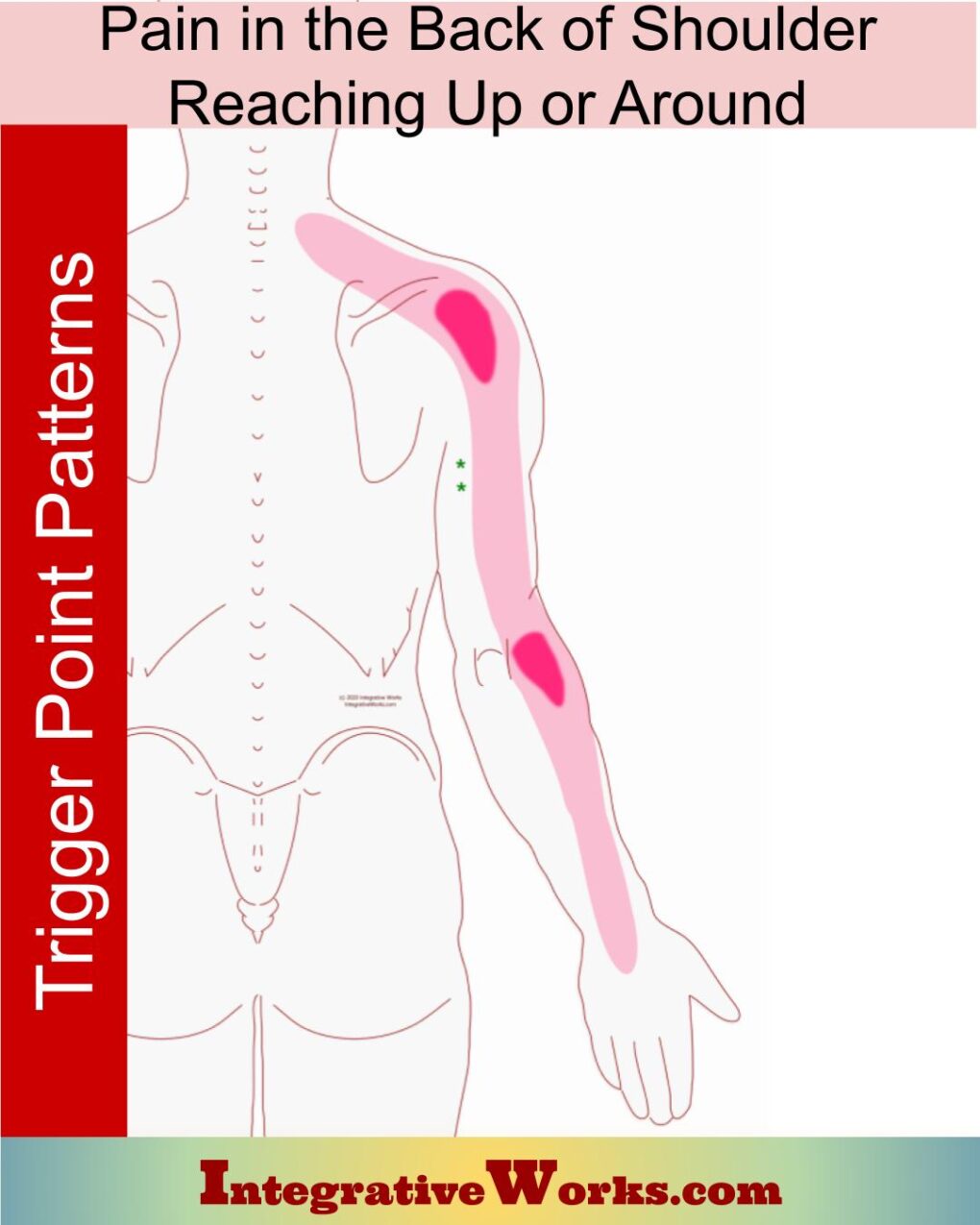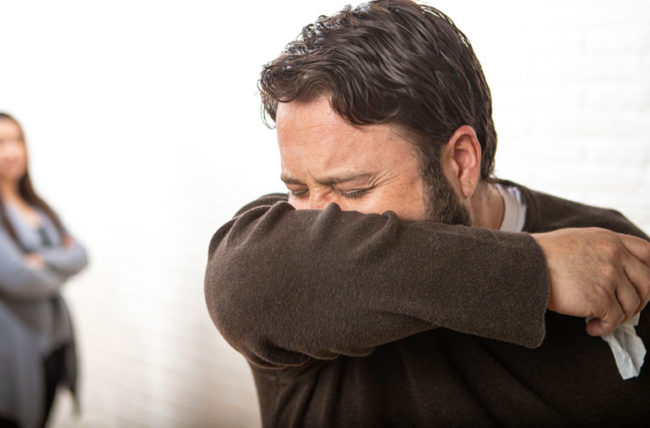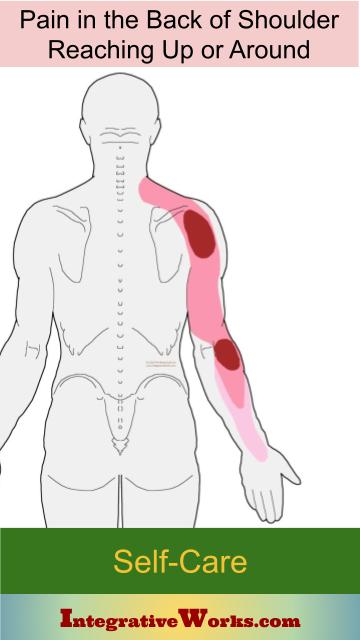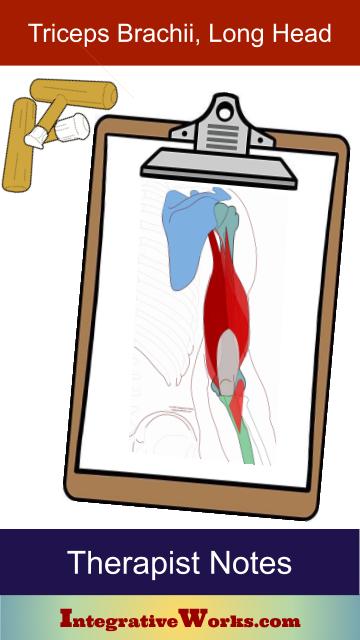Table of Contents
- How People Describe This Pain Pattern
- How You Activate and Intensify This Pain Pattern
- Self-Care – Getting Relief on Your Own
- Musculoskeletal Anatomy Behind Your Pain
- Therapy Notes for Massage and Bodywork
Want to skip ahead?
Here’s a link to my post about
getting relief on your own.
How People Describe This Pain Pattern
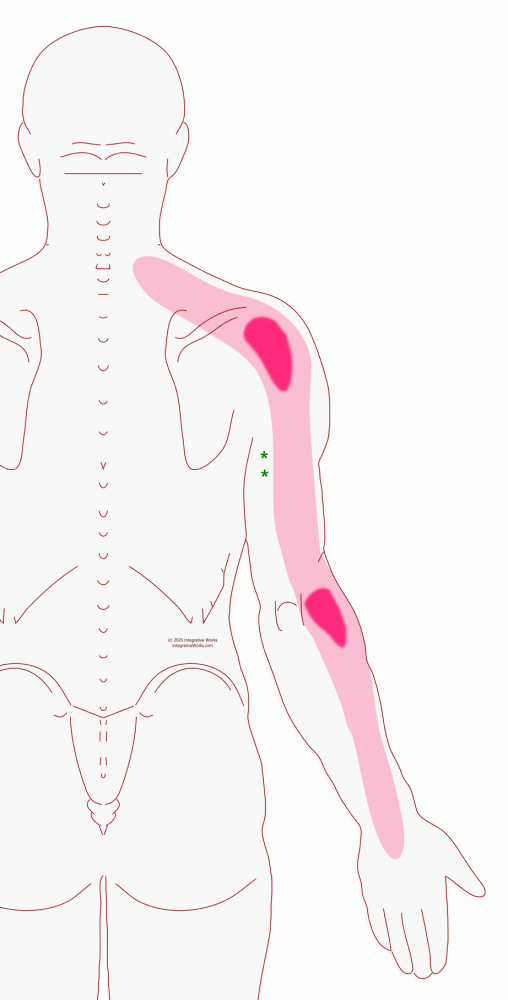
People usually complain of vague pain in the back of the arm that is sharper at the shoulder. This pain often occurs in passive postures where they are using the long head of the triceps to stabilize the arm.
This trigger point has two different focuses of pain. The focus of pain at the shoulder tends to be activated when there is more stretch by moving the shoulder. The pain at the elbow tends to be activated when the movement is more at the elbow.
Movement at the Shoulder
This might happen when they are holding their arms crossed during crowded travel. One patient has this pain while talking with clients with his arms crossed. This twisting to fold the arms and hold them together creates a twist at the triceps’ top end.
It could also happen when they are reaching out for a while. This happens to a speech therapist when tending to the face of a child across from them.
This produces pain and restriction while serving a tennis ball. As well, the restricted shoulder and the weakened triceps hurt the power in the serve. This activates when the server has good reach the arm over the shoulder. When this bothers them, the arm and elbow don’t get as straight overhead.
In fact, the test for this trigger point is to raise both arms overhead. When this trigger point is active, the shoulder and elbow have trouble getting as straight overhead as the opposite shoulder. When I show this to patients in the mirror, most of them are surprised at their difficulty in straightening the elbow on that side.
How You Activate and Intensify This Pain Pattern
Sneezing
Jerking the elbow across often irritates this. It’s the perfect combination of raising the shoulder and bending the elbow sharply in a quick, jerky motion.
Pushing While Stabilizing
Seated triceps extensions also create this pain. The movement of dropping the dumbbell behind your head is almost the same as the stretch for this muscle. The pain is worse when the movement is jerky, too heavy, or too deep before the arm is warm. Even after the arm is warm, the trigger points rob the muscle of power.
Crutches also aggravate this trigger point, and they create more than one problem. First, the crutch pushes into the long head of the triceps, which aggravates the trigger point. Secondly, the motion of stabilizing the crutch while pushing down overworks the long head.
And Sports
As mentioned above, this can create pain when serving tennis. The quick jerk into the serve aggravates the triceps. People often see this as a rotator cuff problem when a little triceps work is all they need. By the way, it is less obvious but also a problem in other sports that reach up like volleyball, golf, and basketball.
Musculoskeletal Anatomy
This post on anatomy contains standard information about the origin, insertion, function, and innervation of muscles. Additionally, it includes information on functional considerations and anomalies.
Find Related Posts
Anatomy posts have a grid of all related posts. This includes posts on pain patterns, self-care, therapy notes, NMT protocols, cranial techniques, and cases.
Getting Relief on Your Own
Clinically Proven
Self-Care Strategies
This post has strategies for getting relief on your own. Explore how to change your activities, stretch, and other strategies that relieve the pain associated with this trigger point.
Therapy Notes for Massage and Bodywork
Better Bodywork
Through Shared Expertise
This post has techniques, tips, treatment routines, and anatomy illustrations to improve the bodyworker’s approach.
Cranio Cradle Cup
This mug has classic, colorful illustrations of the craniosacral system and vault hold #3. It makes a great gift and conversation piece.
Tony Preston has a practice in Atlanta, Georgia, where he sees clients. He has written materials and instructed classes since the mid-90s. This includes anatomy, trigger points, cranial, and neuromuscular.
Question? Comment? Typo?
integrativeworks@gmail.com
Interested in a session with Tony?
Call 404-226-1363
Follow us on Instagram

*This site is undergoing significant changes. We are reformatting and expanding the posts to make them easier to read. The result will also be more accessible and include more patterns with better self-care. Meanwhile, there may be formatting, content presentation, and readability inconsistencies. Until we get older posts updated, please excuse our mess.

